Yixuan Li
RxnBench: A Multimodal Benchmark for Evaluating Large Language Models on Chemical Reaction Understanding from Scientific Literature
Dec 30, 2025Abstract:The integration of Multimodal Large Language Models (MLLMs) into chemistry promises to revolutionize scientific discovery, yet their ability to comprehend the dense, graphical language of reactions within authentic literature remains underexplored. Here, we introduce RxnBench, a multi-tiered benchmark designed to rigorously evaluate MLLMs on chemical reaction understanding from scientific PDFs. RxnBench comprises two tasks: Single-Figure QA (SF-QA), which tests fine-grained visual perception and mechanistic reasoning using 1,525 questions derived from 305 curated reaction schemes, and Full-Document QA (FD-QA), which challenges models to synthesize information from 108 articles, requiring cross-modal integration of text, schemes, and tables. Our evaluation of MLLMs reveals a critical capability gap: while models excel at extracting explicit text, they struggle with deep chemical logic and precise structural recognition. Notably, models with inference-time reasoning significantly outperform standard architectures, yet none achieve 50\% accuracy on FD-QA. These findings underscore the urgent need for domain-specific visual encoders and stronger reasoning engines to advance autonomous AI chemists.
FluencyVE: Marrying Temporal-Aware Mamba with Bypass Attention for Video Editing
Dec 24, 2025Abstract:Large-scale text-to-image diffusion models have achieved unprecedented success in image generation and editing. However, extending this success to video editing remains challenging. Recent video editing efforts have adapted pretrained text-to-image models by adding temporal attention mechanisms to handle video tasks. Unfortunately, these methods continue to suffer from temporal inconsistency issues and high computational overheads. In this study, we propose FluencyVE, which is a simple yet effective one-shot video editing approach. FluencyVE integrates the linear time-series module, Mamba, into a video editing model based on pretrained Stable Diffusion models, replacing the temporal attention layer. This enables global frame-level attention while reducing the computational costs. In addition, we employ low-rank approximation matrices to replace the query and key weight matrices in the causal attention, and use a weighted averaging technique during training to update the attention scores. This approach significantly preserves the generative power of the text-to-image model while effectively reducing the computational burden. Experiments and analyses demonstrate promising results in editing various attributes, subjects, and locations in real-world videos.
Human Motion Estimation with Everyday Wearables
Dec 24, 2025Abstract:While on-body device-based human motion estimation is crucial for applications such as XR interaction, existing methods often suffer from poor wearability, expensive hardware, and cumbersome calibration, which hinder their adoption in daily life. To address these challenges, we present EveryWear, a lightweight and practical human motion capture approach based entirely on everyday wearables: a smartphone, smartwatch, earbuds, and smart glasses equipped with one forward-facing and two downward-facing cameras, requiring no explicit calibration before use. We introduce Ego-Elec, a 9-hour real-world dataset covering 56 daily activities across 17 diverse indoor and outdoor environments, with ground-truth 3D annotations provided by the motion capture (MoCap), to facilitate robust research and benchmarking in this direction. Our approach employs a multimodal teacher-student framework that integrates visual cues from egocentric cameras with inertial signals from consumer devices. By training directly on real-world data rather than synthetic data, our model effectively eliminates the sim-to-real gap that constrains prior work. Experiments demonstrate that our method outperforms baseline models, validating its effectiveness for practical full-body motion estimation.
The World is Your Canvas: Painting Promptable Events with Reference Images, Trajectories, and Text
Dec 18, 2025


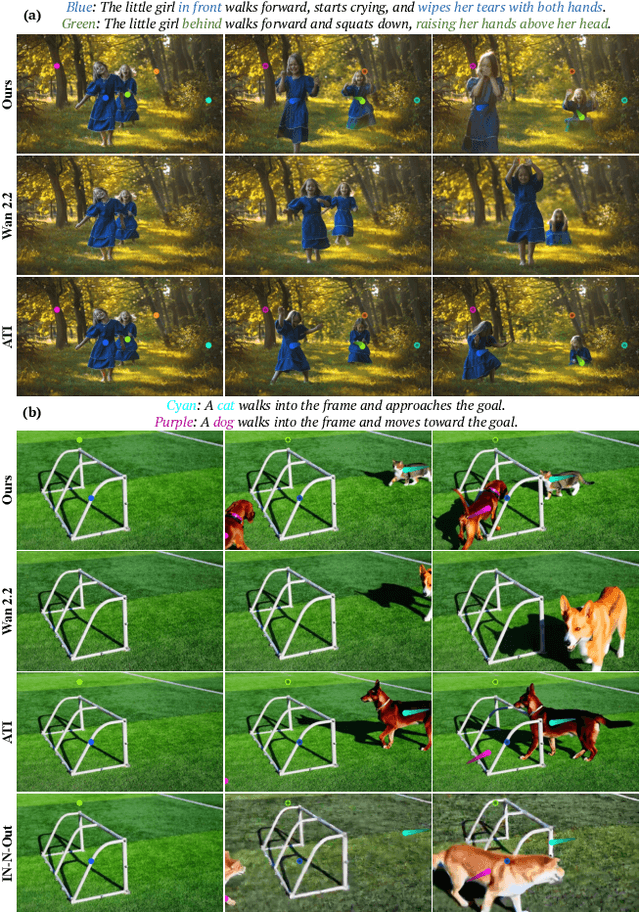
Abstract:We present WorldCanvas, a framework for promptable world events that enables rich, user-directed simulation by combining text, trajectories, and reference images. Unlike text-only approaches and existing trajectory-controlled image-to-video methods, our multimodal approach combines trajectories -- encoding motion, timing, and visibility -- with natural language for semantic intent and reference images for visual grounding of object identity, enabling the generation of coherent, controllable events that include multi-agent interactions, object entry/exit, reference-guided appearance and counterintuitive events. The resulting videos demonstrate not only temporal coherence but also emergent consistency, preserving object identity and scene despite temporary disappearance. By supporting expressive world events generation, WorldCanvas advances world models from passive predictors to interactive, user-shaped simulators. Our project page is available at: https://worldcanvas.github.io/.
MATAI: A Generalist Machine Learning Framework for Property Prediction and Inverse Design of Advanced Alloys
Nov 13, 2025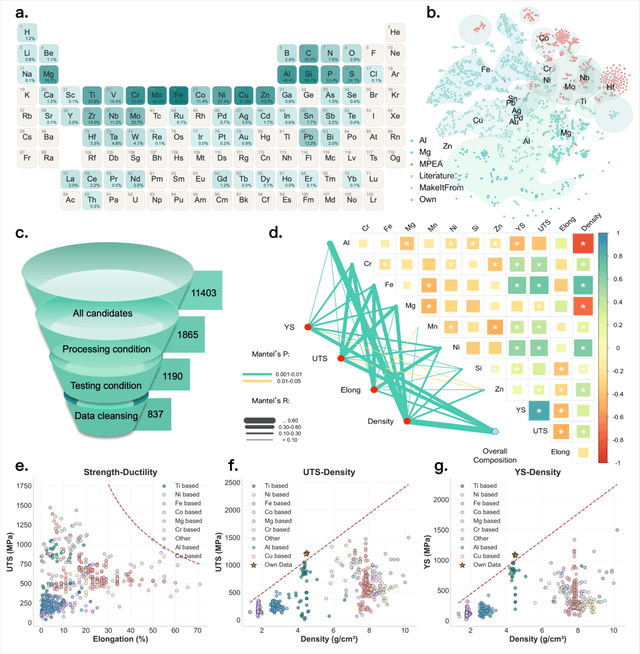
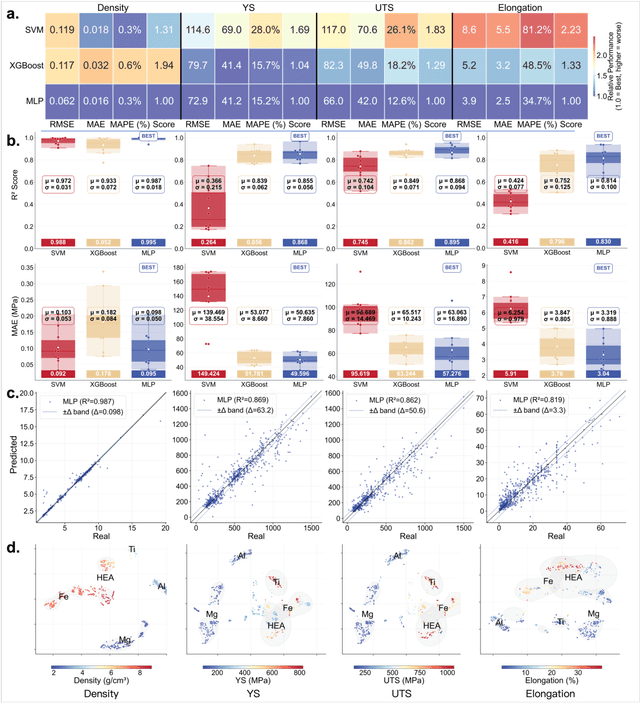
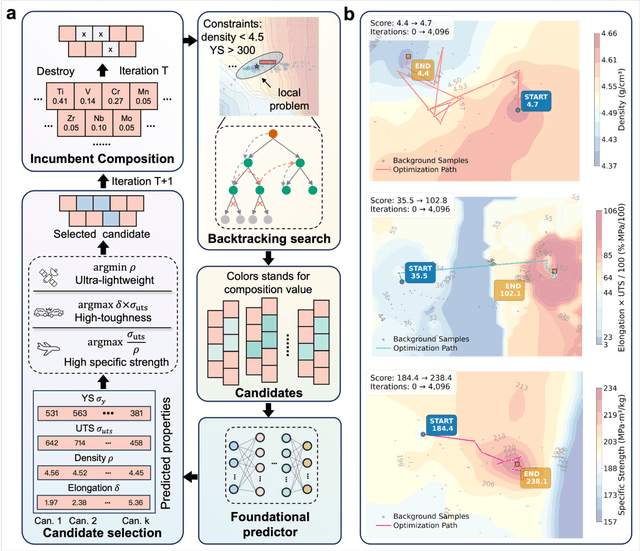
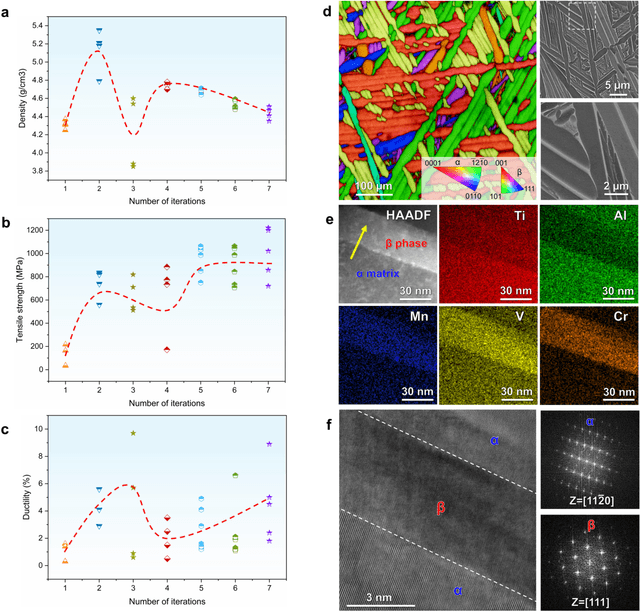
Abstract:The discovery of advanced metallic alloys is hindered by vast composition spaces, competing property objectives, and real-world constraints on manufacturability. Here we introduce MATAI, a generalist machine learning framework for property prediction and inverse design of as-cast alloys. MATAI integrates a curated alloy database, deep neural network-based property predictors, a constraint-aware optimization engine, and an iterative AI-experiment feedback loop. The framework estimates key mechanical propertie, sincluding density, yield strength, ultimate tensile strength, and elongation, directly from composition, using multi-task learning and physics-informed inductive biases. Alloy design is framed as a constrained optimization problem and solved using a bi-level approach that combines local search with symbolic constraint programming. We demonstrate MATAI's capabilities on the Ti-based alloy system, a canonical class of lightweight structural materials, where it rapidly identifies candidates that simultaneously achieve lower density (<4.45 g/cm3), higher strength (>1000 MPa) and appreciable ductility (>5%) through only seven iterations. Experimental validation confirms that MATAI-designed alloys outperform commercial references such as TC4, highlighting the framework's potential to accelerate the discovery of lightweight, high-performance materials under real-world design constraints.
Learning Sparse Approximate Inverse Preconditioners for Conjugate Gradient Solvers on GPUs
Oct 31, 2025



Abstract:The conjugate gradient solver (CG) is a prevalent method for solving symmetric and positive definite linear systems Ax=b, where effective preconditioners are crucial for fast convergence. Traditional preconditioners rely on prescribed algorithms to offer rigorous theoretical guarantees, while limiting their ability to exploit optimization from data. Existing learning-based methods often utilize Graph Neural Networks (GNNs) to improve the performance and speed up the construction. However, their reliance on incomplete factorization leads to significant challenges: the associated triangular solve hinders GPU parallelization in practice, and introduces long-range dependencies which are difficult for GNNs to model. To address these issues, we propose a learning-based method to generate GPU-friendly preconditioners, particularly using GNNs to construct Sparse Approximate Inverse (SPAI) preconditioners, which avoids triangular solves and requires only two matrix-vector products at each CG step. The locality of matrix-vector product is compatible with the local propagation mechanism of GNNs. The flexibility of GNNs also allows our approach to be applied in a wide range of scenarios. Furthermore, we introduce a statistics-based scale-invariant loss function. Its design matches CG's property that the convergence rate depends on the condition number, rather than the absolute scale of A, leading to improved performance of the learned preconditioner. Evaluations on three PDE-derived datasets and one synthetic dataset demonstrate that our method outperforms standard preconditioners (Diagonal, IC, and traditional SPAI) and previous learning-based preconditioners on GPUs. We reduce solution time on GPUs by 40%-53% (68%-113% faster), along with better condition numbers and superior generalization performance. Source code available at https://github.com/Adversarr/LearningSparsePreconditioner4GPU
HoloCine: Holistic Generation of Cinematic Multi-Shot Long Video Narratives
Oct 23, 2025Abstract:State-of-the-art text-to-video models excel at generating isolated clips but fall short of creating the coherent, multi-shot narratives, which are the essence of storytelling. We bridge this "narrative gap" with HoloCine, a model that generates entire scenes holistically to ensure global consistency from the first shot to the last. Our architecture achieves precise directorial control through a Window Cross-Attention mechanism that localizes text prompts to specific shots, while a Sparse Inter-Shot Self-Attention pattern (dense within shots but sparse between them) ensures the efficiency required for minute-scale generation. Beyond setting a new state-of-the-art in narrative coherence, HoloCine develops remarkable emergent abilities: a persistent memory for characters and scenes, and an intuitive grasp of cinematic techniques. Our work marks a pivotal shift from clip synthesis towards automated filmmaking, making end-to-end cinematic creation a tangible future. Our code is available at: https://holo-cine.github.io/.
Learning Human-Humanoid Coordination for Collaborative Object Carrying
Oct 16, 2025Abstract:Human-humanoid collaboration shows significant promise for applications in healthcare, domestic assistance, and manufacturing. While compliant robot-human collaboration has been extensively developed for robotic arms, enabling compliant human-humanoid collaboration remains largely unexplored due to humanoids' complex whole-body dynamics. In this paper, we propose a proprioception-only reinforcement learning approach, COLA, that combines leader and follower behaviors within a single policy. The model is trained in a closed-loop environment with dynamic object interactions to predict object motion patterns and human intentions implicitly, enabling compliant collaboration to maintain load balance through coordinated trajectory planning. We evaluate our approach through comprehensive simulator and real-world experiments on collaborative carrying tasks, demonstrating the effectiveness, generalization, and robustness of our model across various terrains and objects. Simulation experiments demonstrate that our model reduces human effort by 24.7%. compared to baseline approaches while maintaining object stability. Real-world experiments validate robust collaborative carrying across different object types (boxes, desks, stretchers, etc.) and movement patterns (straight-line, turning, slope climbing). Human user studies with 23 participants confirm an average improvement of 27.4% compared to baseline models. Our method enables compliant human-humanoid collaborative carrying without requiring external sensors or complex interaction models, offering a practical solution for real-world deployment.
Hybrid Reinforcement: When Reward Is Sparse, It's Better to Be Dense
Oct 08, 2025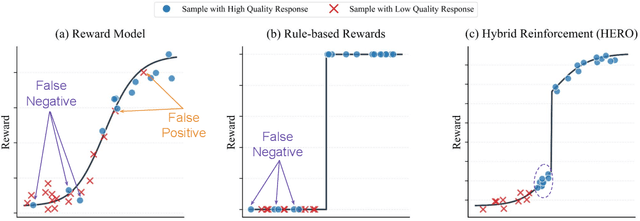
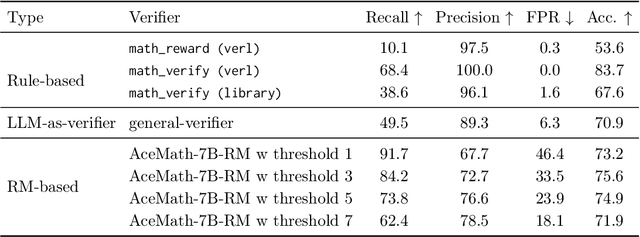


Abstract:Post-training for reasoning of large language models (LLMs) increasingly relies on verifiable rewards: deterministic checkers that provide 0-1 correctness signals. While reliable, such binary feedback is brittle--many tasks admit partially correct or alternative answers that verifiers under-credit, and the resulting all-or-nothing supervision limits learning. Reward models offer richer, continuous feedback, which can serve as a complementary supervisory signal to verifiers. We introduce HERO (Hybrid Ensemble Reward Optimization), a reinforcement learning framework that integrates verifier signals with reward-model scores in a structured way. HERO employs stratified normalization to bound reward-model scores within verifier-defined groups, preserving correctness while refining quality distinctions, and variance-aware weighting to emphasize challenging prompts where dense signals matter most. Across diverse mathematical reasoning benchmarks, HERO consistently outperforms RM-only and verifier-only baselines, with strong gains on both verifiable and hard-to-verify tasks. Our results show that hybrid reward design retains the stability of verifiers while leveraging the nuance of reward models to advance reasoning.
Detecting Distillation Data from Reasoning Models
Oct 06, 2025Abstract:Reasoning distillation has emerged as an efficient and powerful paradigm for enhancing the reasoning capabilities of large language models. However, reasoning distillation may inadvertently cause benchmark contamination, where evaluation data included in distillation datasets can inflate performance metrics of distilled models. In this work, we formally define the task of distillation data detection, which is uniquely challenging due to the partial availability of distillation data. Then, we propose a novel and effective method Token Probability Deviation (TBD), which leverages the probability patterns of the generated output tokens. Our method is motivated by the analysis that distilled models tend to generate near-deterministic tokens for seen questions, while producing more low-probability tokens for unseen questions. Our key idea behind TBD is to quantify how far the generated tokens' probabilities deviate from a high reference probability. In effect, our method achieves competitive detection performance by producing lower scores for seen questions than for unseen questions. Extensive experiments demonstrate the effectiveness of our method, achieving an AUC of 0.918 and a TPR@1% FPR of 0.470 on the S1 dataset.
 Add to Chrome
Add to Chrome Add to Firefox
Add to Firefox Add to Edge
Add to Edge